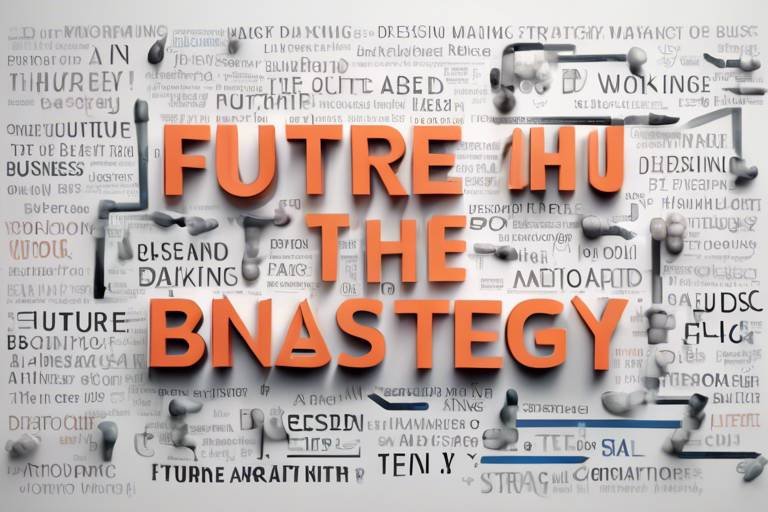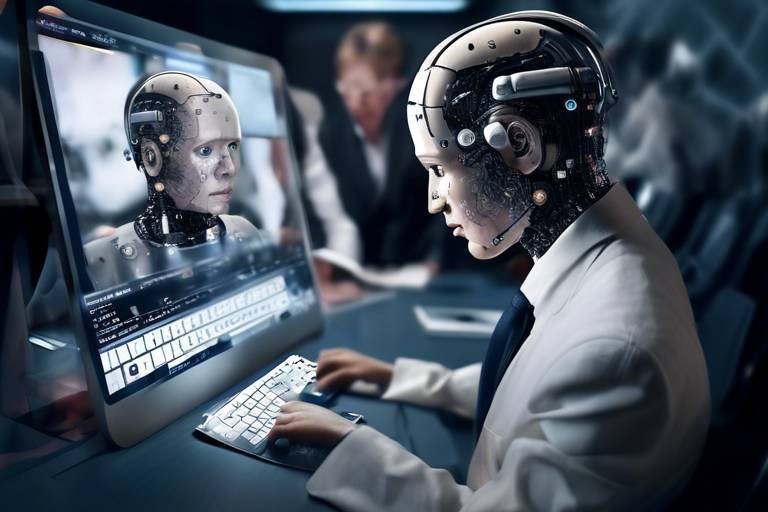How AI is Reshaping the Future of Investing
The world of investing is undergoing a seismic shift, and at the heart of this transformation is artificial intelligence (AI). Imagine a world where investment decisions are not just based on gut feelings or outdated data, but rather on sophisticated algorithms that analyze vast amounts of information in real-time. Sounds futuristic, right? Well, it’s happening now! AI is revolutionizing investment strategies, market analysis, and decision-making processes, making it easier for both seasoned investors and newcomers to navigate the complex financial landscape.
So, why is AI such a game-changer in investing? For starters, it brings a level of data analysis capability that was previously unimaginable. With the power of machine learning, AI can sift through mountains of data—think stock prices, economic indicators, news articles, and social media posts—to identify patterns and trends that human analysts might miss. This not only enhances the accuracy of predictions but also allows investors to make more informed decisions, potentially maximizing their returns.
But it’s not just about crunching numbers; AI also introduces a new level of efficiency into the investment process. Automated trading systems, powered by AI, can execute trades at lightning speed, taking advantage of market opportunities as they arise. This means that investors can stay engaged with the market 24/7, reacting to changes in real-time without the emotional biases that often cloud human judgment. Think of it as having a tireless assistant who never sleeps and is always on the lookout for the best deals!
However, the rise of AI in investing is not without its challenges. As we embrace these advanced technologies, we must also confront issues like algorithmic bias and the need for regulatory compliance. It’s crucial to ensure that the algorithms driving these systems are fair and transparent, promoting equal opportunities for all investors. After all, the last thing we want is for technology to inadvertently perpetuate existing inequalities in the financial markets.
In summary, AI is reshaping the future of investing by enhancing data analysis, improving efficiency, and introducing new strategies that could redefine how we think about finance. As we move forward, it’s essential to navigate the ethical implications and regulatory challenges that come with this technological evolution. The future of investing is bright, but it’s up to us to ensure it’s also fair and inclusive.
- What is AI in investing? AI in investing refers to the use of artificial intelligence technologies to analyze data, predict market trends, and make investment decisions.
- How does AI improve investment strategies? AI enhances investment strategies by providing advanced data analysis, enabling predictive modeling, and automating trading processes.
- What are the risks associated with AI in investing? Risks include algorithmic bias, system failures, and market volatility, which can affect trading outcomes.
- Can AI completely replace human investors? While AI can significantly enhance decision-making, human oversight is still crucial to ensure ethical considerations and manage risks.

The Rise of AI in Investment Strategies
Artificial Intelligence (AI) is not just a buzzword anymore; it's a game-changer in the realm of investing. As we navigate through an increasingly complex financial landscape, AI technologies are stepping up to the plate, offering investors enhanced data analysis capabilities and predictive modeling. Imagine having a personal financial advisor that works 24/7, crunching numbers and analyzing trends faster than any human could. This is what AI brings to the table, transforming traditional investment strategies into something far more dynamic and efficient.
With the integration of AI, investors can now tap into a wealth of information that was previously inaccessible or too cumbersome to analyze. For instance, AI algorithms can sift through vast datasets, uncovering hidden patterns that can inform investment decisions. This capability allows investors to make more informed choices, maximizing returns while minimizing risks. But how does this work, exactly? Let's break it down.
AI in investment strategies operates on several fronts:
- Data Collection: AI systems can gather data from multiple sources, including market trends, economic indicators, and even social media sentiment. This comprehensive data collection is crucial for making informed decisions.
- Predictive Analytics: By utilizing machine learning algorithms, AI can predict future market movements based on historical data. This foresight allows investors to adjust their strategies proactively.
- Real-time Analysis: AI tools can analyze market conditions in real-time, providing insights that help investors react swiftly to changes.
The evolution of AI in investment strategies also signifies a shift towards more personalized investment approaches. Investors can now benefit from tailored recommendations that align with their unique risk profiles and financial goals. This personalization is achieved through sophisticated algorithms that learn from individual investor behavior and preferences, making the investment experience more engaging and effective.
However, the rise of AI in investment strategies isn't without its challenges. Investors must navigate the complexities of integrating these technologies into their existing frameworks. For instance, understanding how to interpret AI-generated insights and implementing them effectively can be daunting. Moreover, the reliance on AI raises questions about transparency and accountability. Are we fully aware of how these algorithms make decisions? This is where the conversation about ethical implications comes into play.
In summary, the rise of AI in investment strategies is reshaping how we approach investing. With its ability to analyze vast amounts of data, predict market trends, and personalize investment strategies, AI is proving to be an indispensable tool for modern investors. As we continue to explore this technological evolution, it's essential to stay informed about both the opportunities and challenges it presents.

Machine Learning Algorithms in Trading
In recent years, machine learning algorithms have emerged as a game-changer in the world of trading. These sophisticated systems analyze vast amounts of data at lightning speed, identifying patterns and trends that would take human analysts an eternity to uncover. Imagine having a super-smart assistant who can sift through thousands of market reports, social media posts, and historical price movements in mere seconds—this is what machine learning brings to the table.
What makes machine learning particularly fascinating is its ability to learn from new data continuously. As the market evolves, so do these algorithms, adjusting their strategies based on real-time information. This adaptability means that traders can stay ahead of the curve, making informed decisions that are often backed by predictive insights. For instance, a machine learning model can analyze past trades and current market conditions to forecast the likelihood of a stock's price movement, empowering traders to act quickly and decisively.
To illustrate how machine learning enhances trading, consider the following key areas where these algorithms excel:
- Pattern Recognition: Machine learning can identify intricate patterns in data that may not be immediately apparent to human traders. This capability allows for the detection of emerging market trends before they become widely recognized.
- Risk Assessment: Algorithms can evaluate the risk associated with different trading strategies by analyzing historical data and market volatility, helping traders to make safer investment choices.
- Trade Execution: Speed is crucial in trading. Machine learning algorithms can execute trades in milliseconds, capitalizing on fleeting market opportunities that human traders might miss.
However, while the advantages of machine learning in trading are evident, it’s essential to acknowledge the challenges that come with it. One significant concern is the overfitting of models, where an algorithm becomes too tailored to historical data and fails to perform well in real-world scenarios. Additionally, the reliance on algorithms can sometimes lead to a lack of human intuition, which is vital in navigating unpredictable market conditions.
As traders increasingly turn to machine learning, they must strike a balance between leveraging technology and maintaining the human touch. After all, trading is as much an art as it is a science. The combination of human insight and machine learning could very well be the winning formula for future trading success.
Q1: What is machine learning in trading?
Machine learning in trading refers to the use of algorithms that analyze data to predict market trends and make trading decisions. These algorithms learn from historical data and adapt to new information to improve their accuracy.
Q2: How does machine learning improve trading strategies?
Machine learning enhances trading strategies by providing insights through data analysis, identifying patterns that may not be visible to human traders, and executing trades at optimal times based on predictive analytics.
Q3: What are the risks associated with using machine learning in trading?
The primary risks include overfitting, where models perform well on historical data but fail in live markets, and the potential for a lack of human intuition in decision-making, which can be crucial in volatile market conditions.
Q4: Can machine learning algorithms replace human traders?
While machine learning algorithms can significantly enhance trading efficiency and decision-making, they are not likely to fully replace human traders. The best results often come from a combination of human insight and machine learning capabilities.

Automated Trading Systems
Automated trading systems are at the forefront of the financial revolution, acting like the well-oiled machines of the investment world. These systems leverage the power of artificial intelligence to execute trades with precision and speed that human traders simply cannot match. Imagine having a tireless assistant who works around the clock, analyzing market data, and making trades based on pre-defined criteria. Sounds incredible, right? That's exactly what automated trading systems do. They analyze vast amounts of data in real-time, identifying optimal trading opportunities and executing orders in a fraction of a second.
One of the most significant advantages of these systems is their ability to eliminate human emotions from trading decisions. Emotions like fear and greed can cloud judgment and lead to poor investment choices. By relying on algorithms and predefined strategies, automated trading systems minimize these emotional biases, allowing for a more disciplined approach to trading. This is particularly beneficial during times of market volatility when emotions can run high.
But how do these systems work? At the core, they utilize machine learning algorithms to analyze historical data and identify patterns. Once these patterns are established, the system can make predictions about future market movements. This predictive capability enables traders to execute trades at the most opportune moments, maximizing their potential returns. For instance, an automated trading system might analyze historical price movements and trading volumes to determine the best time to buy or sell a particular asset.
Moreover, the efficiency of automated trading systems allows them to operate 24/7. Unlike human traders who need rest, these systems can continuously monitor the markets, ensuring that no opportunity is missed. This constant engagement is essential in today’s fast-paced trading environment, where market conditions can change rapidly. The ability to react instantly to market fluctuations is a game-changer for investors looking to gain an edge over their competitors.
However, it's important to note that automated trading is not without its challenges. While these systems can significantly enhance trading efficiency, they also come with risks. For example, a sudden market shift can lead to unintended consequences if the algorithms do not adapt quickly enough. Additionally, technical glitches or system failures can result in substantial losses. Therefore, it’s crucial for investors to regularly monitor their automated trading systems and ensure that they are functioning as intended.
In summary, automated trading systems represent a significant advancement in the world of investing. They offer numerous benefits, including increased efficiency, elimination of emotional biases, and the ability to operate continuously. However, like any tool, they require careful management and oversight to mitigate potential risks. As technology continues to evolve, the role of automated trading systems will likely become even more integral to investment strategies.
- What is an automated trading system? An automated trading system is a computer program that uses algorithms to execute trades based on predefined criteria without human intervention.
- How does automated trading reduce emotional bias? By relying on algorithms, automated trading systems make decisions based on data rather than emotions, leading to more disciplined trading.
- Can automated trading systems guarantee profits? While they can improve efficiency and decision-making, no trading system can guarantee profits due to the unpredictable nature of financial markets.
- What are the risks associated with automated trading? Risks include technical failures, market volatility, and the potential for algorithms to react poorly to sudden market changes.

Benefits of Automation in Trading
Automation in trading is not just a trend; it's a game-changer that has transformed how investors approach the markets. By leveraging advanced algorithms and artificial intelligence, traders can operate at a level of efficiency that was previously unimaginable. One of the most significant benefits of automation is the ability to engage with the market **24/7**. Unlike traditional trading methods that rely on human oversight, automated systems can continuously monitor market conditions and execute trades at any time. This means that opportunities are never missed, whether it’s during the day or in the wee hours of the night.
Another crucial advantage is the drastic reduction of human error. Emotions can cloud judgment, leading to poor decision-making, especially in high-pressure situations. Automated trading systems eliminate this risk by executing trades based on pre-set criteria and algorithms, ensuring that decisions are made based on data rather than feelings. Picture this: a trader might hesitate to sell a stock during a minor dip due to fear of missing out on a rebound. An automated system, on the other hand, would execute the sale instantly, adhering strictly to its programmed strategy.
Moreover, automation allows traders to handle complex strategies without the need for constant oversight. For instance, many traders employ strategies that involve multiple assets and intricate parameters. Manually managing such strategies can be overwhelming and time-consuming. However, automated systems can seamlessly manage these complexities, analyzing vast amounts of data and adjusting positions as needed. This not only saves time but also allows traders to focus on refining their strategies rather than getting bogged down in the minutiae of execution.
In addition to these benefits, automated trading systems can also minimize reaction time to market changes. In today's fast-paced trading environment, every second counts. Automated systems can react to market fluctuations within milliseconds, executing trades faster than any human trader could. This speed can be the difference between a profitable trade and a missed opportunity. For example, if a stock suddenly drops due to unexpected news, an automated system can quickly sell off holdings before losses mount, whereas a human trader might still be processing the news.
Lastly, let's not forget the potential for enhanced backtesting capabilities. Automated systems can analyze historical data to test trading strategies under various market conditions. This allows traders to refine their approaches based on empirical evidence rather than speculation. By understanding how a strategy would have performed in the past, traders can make more informed decisions about future investments. Overall, the benefits of automation in trading are profound, offering a blend of speed, efficiency, and accuracy that can significantly enhance an investor's ability to navigate the complexities of the financial markets.
- What is automated trading? Automated trading refers to the use of algorithms and software to execute trades without human intervention, based on predefined criteria.
- How does automation reduce human error? Automation removes emotional biases and hesitations in trading decisions, executing trades strictly based on data and programmed strategies.
- Can automated trading systems operate 24/7? Yes, automated systems can monitor and trade in the markets continuously, allowing for opportunities to be seized at any time.
- What are the risks associated with automated trading? While automation offers many benefits, it can also pose risks such as system failures and market volatility, which require careful monitoring.

Challenges of Automated Trading
While automated trading systems offer numerous benefits, they also come with a set of significant challenges that investors must navigate. One of the primary concerns is the risk of system failures. These failures can occur due to technical glitches, connectivity issues, or software bugs, potentially leading to substantial financial losses. Imagine relying on a car that suddenly stalls in the middle of a busy intersection—this is akin to what can happen in automated trading when systems fail unexpectedly.
Another challenge is the inherent market volatility. Automated trading systems often react to market fluctuations at lightning speed, which can be both a blessing and a curse. When the market experiences sudden changes, these systems may execute trades based on outdated data or algorithms that are not equipped to handle such volatility. This can result in a cascade of automated trades that exacerbate market downturns, creating a domino effect that can be detrimental to overall market stability.
Moreover, emotional biases that humans typically exhibit can sometimes be inadvertently programmed into these systems. If the algorithms are based on flawed assumptions or incomplete data, they may make decisions that are not aligned with the current market conditions. This is akin to following a recipe that calls for outdated ingredients; the final dish may not turn out as expected. Therefore, ensuring that algorithms are regularly updated and refined is essential.
Lastly, there is the concern of market manipulation. With the rise of high-frequency trading and other sophisticated automated strategies, there is a growing risk that certain market participants could exploit these systems to manipulate prices. This raises ethical questions about fairness and transparency in the markets. Investors must remain vigilant, ensuring that the automated systems they employ adhere to ethical standards and regulatory guidelines.
In summary, while automated trading presents exciting opportunities, investors must be aware of these challenges to navigate the complex landscape effectively. Understanding the risks involved and implementing robust risk management strategies can help mitigate these challenges, allowing investors to harness the full potential of automated trading.
- What is automated trading? Automated trading refers to the use of computer algorithms to execute trades based on predefined criteria, eliminating the need for human intervention.
- What are the main benefits of automated trading? Benefits include increased speed of trade execution, reduced emotional bias, and the ability to monitor multiple markets simultaneously.
- How can I mitigate risks associated with automated trading? Regularly updating algorithms, implementing risk management strategies, and conducting thorough backtesting can help mitigate risks.
- Is automated trading suitable for all investors? Not necessarily. Automated trading requires a solid understanding of market dynamics and technology, making it more suitable for experienced investors.

Sentiment Analysis and Market Predictions
In the fast-paced world of investing, understanding market sentiment can be the secret sauce that separates successful investors from the rest. Sentiment analysis leverages the power of artificial intelligence to sift through mountains of data, including social media chatter, news articles, and financial reports, to gauge public sentiment about specific stocks, sectors, or the market as a whole. Imagine having a crystal ball that not only tells you what people are saying but also predicts how their feelings might influence market movements. That's precisely what AI-driven sentiment analysis offers!
With the ability to analyze vast amounts of unstructured data, these tools can identify trends and shifts in investor behavior that traditional methods might miss. For instance, if a company is receiving negative press on social media, sentiment analysis can quantify this negativity and provide insights into how it may affect the stock price. This is crucial because, as we know, market reactions are often driven by emotions rather than just hard data.
Consider this: a recent study indicated that over 70% of market movements could be attributed to investor sentiment rather than fundamental factors alone. Therefore, having access to real-time sentiment analysis can empower investors to make more informed decisions. By analyzing sentiment, investors can:
- Identify potential buying or selling opportunities based on public perception.
- Anticipate market corrections or rallies resulting from shifts in sentiment.
- Adjust their strategies proactively rather than reactively.
However, while sentiment analysis provides valuable insights, it's essential to approach it with a critical eye. Not all sentiment is created equal. For example, a surge in positive sentiment might not always lead to a corresponding increase in stock prices if the underlying fundamentals do not support it. This is where the combination of sentiment analysis with other analytical tools becomes vital. By integrating sentiment data with traditional financial metrics, investors can achieve a more comprehensive view of the market landscape.
In summary, AI-driven sentiment analysis is not just a buzzword; it's a game-changer in the realm of investing. By harnessing the collective voice of the market, investors can navigate the complexities of market predictions with greater confidence and precision. As technology continues to evolve, the integration of sentiment analysis into investment strategies will likely become a standard practice, providing a competitive edge to those who embrace it.
- What is sentiment analysis in investing?
Sentiment analysis is the process of using AI to evaluate public opinion on social media, news articles, and other platforms to gauge market sentiment and predict potential market movements. - How does AI improve sentiment analysis?
AI enhances sentiment analysis by processing large volumes of unstructured data quickly and accurately, identifying trends and shifts in sentiment that can impact investment decisions. - Can sentiment analysis guarantee investment success?
No, while sentiment analysis provides valuable insights, it should be used in conjunction with other analytical tools and traditional financial metrics to make informed investment decisions.

Risk Management with AI
In the fast-paced world of investing, risk management has always been a cornerstone of successful strategies. With the advent of artificial intelligence (AI), this critical aspect of investing is undergoing a profound transformation. AI enhances risk management by utilizing advanced algorithms to analyze historical data and current market conditions. This allows investors to identify potential risks more effectively than ever before. Imagine having a financial advisor who never sleeps, constantly analyzing data and providing insights that can save you from significant losses. Sounds like a dream, right? Well, AI is making that dream a reality.
One of the primary advantages of AI in risk management is its ability to process vast amounts of data at lightning speed. Traditional methods often rely on human intuition and experience, which can be limited and subjective. In contrast, AI systems can analyze countless variables, including economic indicators, market trends, and even geopolitical events that might impact investment performance. By leveraging this data, AI can forecast potential risks with impressive accuracy, allowing investors to make informed decisions.
Moreover, AI-driven risk assessment tools can identify high-risk investments that might otherwise go unnoticed. For instance, an AI system can evaluate a stock's volatility and compare it with historical performance, providing insights into whether it's a safe bet or a ticking time bomb. This predictive capability empowers investors to proactively adjust their strategies, potentially saving them from catastrophic losses.
To illustrate the impact of AI on risk management, consider the following table that highlights the differences between traditional risk assessment methods and AI-enhanced approaches:
| Aspect | Traditional Methods | AI-Enhanced Methods |
|---|---|---|
| Data Processing Speed | Slow, manual analysis | Real-time processing of vast datasets |
| Risk Identification | Subjective, based on experience | Objective, data-driven insights |
| Forecasting Accuracy | Limited by human bias | High accuracy through predictive analytics |
| Response Time | Delayed reaction to market changes | Immediate adjustments based on real-time data |
As we delve deeper into the realm of AI and investing, it's essential to recognize that while AI provides incredible advantages, it is not without its challenges. The reliance on algorithms can sometimes lead to overfitting, where models become too tailored to historical data and fail to predict future market behaviors accurately. This is where human oversight remains crucial. Investors must balance the insights provided by AI with their own judgment and experience to navigate the complexities of the market effectively.
In conclusion, AI is revolutionizing risk management in investing by providing tools that enhance decision-making capabilities. By analyzing historical data and current market conditions, AI helps investors identify potential risks and adjust their strategies proactively. However, the integration of AI into risk management should be approached with caution, ensuring that human expertise complements technological advancements. As we embrace this new era of investing, understanding the synergy between AI and traditional methods will be key to maximizing returns while minimizing risks.
- How does AI improve risk management in investing?
AI enhances risk management by analyzing vast datasets to identify potential risks and trends, allowing for proactive adjustments to investment strategies. - What are the limitations of AI in risk management?
AI can sometimes lead to overfitting, where models become too tailored to historical data, potentially failing to predict future market behaviors accurately. - Can AI completely replace human judgment in investing?
No, while AI provides valuable insights, human oversight is crucial for navigating the complexities of the market effectively.

Predictive Analytics for Risk Assessment
In the ever-evolving world of investing, predictive analytics has emerged as a game-changer, especially when it comes to risk assessment. Imagine having a crystal ball that not only forecasts potential market downturns but also identifies high-risk investments before they become a problem. That’s precisely what AI-driven predictive analytics brings to the table. By leveraging vast amounts of historical data and sophisticated algorithms, investors can gain insights that were previously unimaginable.
At its core, predictive analytics uses statistical algorithms and machine learning techniques to analyze historical data and make predictions about future outcomes. This means that investors can assess the likelihood of various risks associated with their portfolios, allowing them to make more informed decisions. For instance, if an investor is considering a particular stock, predictive analytics can provide insights into its past performance under similar market conditions, helping to gauge its potential volatility.
One of the key advantages of predictive analytics is its ability to identify patterns that might not be immediately obvious to the human eye. For example, it can analyze market trends, economic indicators, and even social media sentiment to forecast potential shifts in the market. This holistic approach enables investors to not only react to changes but also to anticipate them. By understanding these patterns, investors can strategically adjust their portfolios to mitigate risks.
To illustrate the impact of predictive analytics, consider the following table that outlines common risk factors and how predictive analytics can address them:
| Risk Factor | Predictive Analytics Solution |
|---|---|
| Market Volatility | Forecasting trends based on historical data |
| Economic Shifts | Analyzing economic indicators for early warnings |
| Sector Performance | Comparing sector trends to identify underperformers |
| Regulatory Changes | Monitoring news and sentiment for potential impacts |
As you can see, predictive analytics offers tailored solutions to various risks, enhancing an investor's ability to navigate the complexities of the market. However, it's crucial to remember that while predictive analytics can significantly improve risk assessment, it is not foolproof. Market dynamics can change rapidly, and unexpected events can still lead to losses. Therefore, it should be used as a tool in conjunction with traditional risk management strategies.
In conclusion, the integration of predictive analytics in risk assessment is revolutionizing how investors approach their portfolios. By harnessing the power of AI, investors can not only foresee potential pitfalls but also capitalize on opportunities that arise from a deeper understanding of market dynamics. As we move forward, embracing these technologies will be essential for anyone looking to thrive in the complex world of investing.
- What is predictive analytics in investing?
Predictive analytics involves using historical data and algorithms to forecast future market trends and assess risks associated with investments. - How does predictive analytics improve risk assessment?
It enhances risk assessment by identifying patterns and trends that can indicate potential market shifts, allowing investors to make informed decisions. - Can predictive analytics guarantee investment success?
No, while it provides valuable insights, it cannot guarantee success due to the unpredictable nature of the market. - What tools are commonly used for predictive analytics?
Many investors use software platforms that incorporate machine learning algorithms and data visualization tools to analyze market data.

Portfolio Optimization Techniques
When it comes to investing, the phrase "don't put all your eggs in one basket" rings especially true. Portfolio optimization is like a finely tuned orchestra, where each instrument plays its part to create a harmonious financial symphony. By leveraging AI-driven techniques, investors can analyze various asset classes and market conditions, ensuring that their portfolios are not only well-diversified but also strategically aligned with their investment goals.
One of the key aspects of portfolio optimization is understanding the risk-return trade-off. Investors often seek to maximize returns while minimizing risks, and this is where AI shines. By employing advanced algorithms, AI can sift through mountains of data to identify the most suitable asset allocations based on historical performance and future projections. Imagine having a personal financial advisor who works 24/7, tirelessly analyzing data to find the best opportunities—that's the power of AI in portfolio optimization.
Moreover, AI can adapt to changing market conditions in real-time. For instance, if a particular sector is underperforming, AI systems can quickly reallocate resources to more promising investments. This dynamic approach not only protects your investments but also enhances the overall performance of your portfolio. To illustrate this, consider the following table that highlights how AI-driven portfolio optimization can impact various asset classes:
| Asset Class | Historical Return (%) | Risk Factor | AI Recommended Allocation (%) |
|---|---|---|---|
| Stocks | 8 | High | 50 |
| Bonds | 5 | Low | 30 |
| Real Estate | 7 | Medium | 15 |
| Commodities | 6 | High | 5 |
In this example, the AI system has suggested an allocation that balances potential returns with acceptable risk levels. This tailored approach is a game changer for investors who may not have the time or expertise to navigate the complexities of the market on their own.
Furthermore, AI can also assist in the ongoing monitoring and adjustment of portfolios. As market conditions fluctuate, the AI can alert investors to necessary changes, ensuring that the portfolio remains aligned with the investor's objectives. This proactive management is akin to having a GPS system for your investments, guiding you through the twists and turns of the financial landscape.
In summary, portfolio optimization techniques powered by AI not only enhance decision-making but also empower investors to achieve a balanced and profitable investment strategy. The future of investing is undoubtedly brighter with these cutting-edge technologies at our disposal.
- What is portfolio optimization? Portfolio optimization is the process of selecting the best asset allocation to maximize returns while minimizing risk.
- How does AI help in portfolio optimization? AI analyzes vast amounts of data to identify optimal asset allocations based on historical performance and market conditions.
- Can AI adjust my portfolio in real-time? Yes, AI can monitor market conditions and suggest adjustments to your portfolio as needed.
- Is portfolio optimization suitable for all investors? While it can benefit most investors, those with unique financial situations should consult with a financial advisor.

The Ethical Implications of AI in Investing
As we dive deeper into the world of artificial intelligence in investing, we can't ignore the ethical implications that come along for the ride. The integration of AI technologies in financial markets is not just a technical evolution; it also raises significant questions about transparency, accountability, and the potential for biased algorithms to influence financial decisions. Imagine a world where your investment choices are swayed not just by data, but by hidden biases in the algorithms that guide them. This scenario is not far-fetched and highlights the urgent need for ethical considerations in AI development.
One of the primary concerns is the issue of algorithmic bias. Algorithms are only as good as the data they're trained on. If the input data contains biases—whether intentional or not—the outputs will likely reflect those biases. This can lead to unfair investment opportunities, where certain groups are favored over others, perpetuating inequality in financial markets. For instance, if an algorithm is trained predominantly on data from a specific demographic, it may not accurately predict market behaviors for other demographics, potentially sidelining diverse investors. Addressing this bias is crucial to ensuring a fair playing field in investing.
Moreover, as AI systems become more prevalent, the question of accountability arises. Who is responsible when an AI-driven investment strategy results in significant losses? Is it the developers of the algorithm, the financial institutions that deploy it, or the investors who relied on it? The lack of clear accountability can lead to a trust deficit among investors, causing them to hesitate in adopting AI-driven strategies. This uncertainty can hinder the overall progress of AI in the financial sector.
Another layer of complexity is added by the regulatory challenges that come with the integration of AI in investing. Financial regulations were designed with traditional investing in mind, and they often struggle to keep pace with rapid technological advancements. Regulators must find a balance between fostering innovation and ensuring that investors are protected from potential risks associated with AI, such as market manipulation or data breaches. This means that compliance with existing laws while adapting to new technologies is essential for maintaining market integrity.
In conclusion, while AI presents exciting opportunities for enhancing investment strategies and optimizing portfolio management, we must tread carefully. The ethical implications of AI in investing are profound and require ongoing dialogue among stakeholders. By addressing issues such as algorithmic bias, accountability, and regulatory compliance, we can work towards a future where AI not only enhances investment outcomes but does so in a fair and equitable manner. After all, investing should be about unlocking potential, not creating barriers.
- What is algorithmic bias in AI? Algorithmic bias occurs when an AI system produces systematic errors due to prejudiced assumptions in the machine learning process, leading to unfair treatment of certain groups.
- How can we ensure accountability in AI-driven investing? Establishing clear guidelines on responsibility and implementing regulatory frameworks can help ensure accountability for AI-driven investment decisions.
- What are the regulatory challenges associated with AI in investing? Regulatory challenges include adapting existing laws to cover AI technologies, ensuring compliance while promoting innovation, and protecting investors from potential risks.

Addressing Algorithmic Bias
As we delve deeper into the world of artificial intelligence in investing, one critical issue stands out: algorithmic bias. This phenomenon occurs when algorithms produce results that are systematically prejudiced due to erroneous assumptions in the machine learning process. Imagine a scenario where an AI system is designed to analyze investment opportunities but inadvertently favors certain demographic groups over others. This bias can lead to unfair advantages in the market and could skew investment decisions, ultimately impacting the financial landscape.
Addressing algorithmic bias is not just a technical challenge; it's a moral imperative. Financial institutions and investors alike must recognize that the algorithms they rely on are only as good as the data fed into them. If the training data reflects existing biases—whether they relate to race, gender, or socioeconomic status—the output will likely perpetuate those biases. To mitigate this risk, organizations should implement a comprehensive strategy that includes:
- Diverse Data Sets: Using a variety of data sources can help ensure that the AI systems are trained on a more balanced representation of the population.
- Regular Audits: Conducting routine evaluations of algorithms can help identify and rectify biases that may have developed over time.
- Transparency: Making the algorithms' decision-making processes clear can foster trust and accountability among investors.
Moreover, collaboration between technologists, ethicists, and financial experts is crucial. By bringing together diverse perspectives, we can create more robust frameworks that not only prioritize profitability but also equity in investment opportunities. For instance, companies can establish ethics boards to oversee AI development, ensuring that ethical considerations are at the forefront of technological advancements.
Ultimately, addressing algorithmic bias is about creating a fairer financial system. When investors have access to unbiased information and opportunities, the market can function more efficiently. This not only benefits individual investors but also contributes to the overall health of the economy. As we continue to embrace AI in investing, let’s ensure that we do so responsibly, paving the way for a more inclusive future.
- What is algorithmic bias?
Algorithmic bias refers to systematic and unfair discrimination in the outputs of an algorithm, often stemming from biased training data.
- How can we reduce algorithmic bias in AI systems?
By using diverse data sets, conducting regular audits, and promoting transparency in AI processes, organizations can work towards minimizing algorithmic bias.
- Why is addressing algorithmic bias important in investing?
It ensures fair investment opportunities and helps maintain market integrity, ultimately benefiting the economy as a whole.

Regulatory Challenges and Compliance
The integration of artificial intelligence in investing is not just a technological evolution; it also brings a host of regulatory challenges that need to be addressed. As financial markets become increasingly reliant on AI-driven tools, regulators are faced with the daunting task of ensuring that these systems operate within the bounds of existing laws. This is particularly challenging given the rapid pace of technological advancement, which often outstrips the ability of regulatory bodies to keep up.
One of the key issues is the transparency of AI algorithms. Investors and regulators alike need to understand how these algorithms make decisions. If an AI system is making trading decisions based on complex algorithms that are not transparent, it raises serious questions about accountability. In the event of a market disruption caused by an AI-driven decision, who is responsible? Is it the developers of the AI, the investors using it, or the financial institutions that implement it? These questions are critical as they touch on the very essence of trust in financial markets.
Moreover, the potential for algorithmic bias poses another significant challenge. AI systems are only as good as the data they are trained on. If the input data contains biases, the AI can perpetuate or even amplify these biases in its decision-making processes. This can lead to unfair advantages for certain groups of investors while disadvantaging others, thereby undermining the principle of a fair market. Addressing these biases is not just a technical challenge; it also requires a commitment to ethical standards and practices within the financial industry.
To tackle these challenges, regulatory bodies are now considering new frameworks that specifically address the unique aspects of AI in finance. For example, some regulators are advocating for the establishment of best practices for AI development and deployment, which could include:
- Regular audits of AI systems to ensure compliance with established guidelines.
- Mandatory reporting of AI-driven trading strategies to enhance transparency.
- Collaboration between AI developers and regulators to create a shared understanding of risks and responsibilities.
Furthermore, as AI technologies continue to develop, regulatory bodies must also adapt their compliance frameworks to accommodate these advancements. This may involve creating new regulations that are specifically tailored to AI applications in finance, or updating existing laws to better reflect the current landscape. The goal is to create a regulatory environment that not only protects investors but also fosters innovation in the financial sector.
In conclusion, while AI holds great promise for transforming the investing landscape, it also presents significant regulatory challenges that must be navigated carefully. By addressing issues of transparency, accountability, and bias, regulators can help ensure that the benefits of AI are realized without compromising the integrity of financial markets.
- What are the main regulatory challenges associated with AI in investing? The main challenges include transparency of algorithms, accountability for AI-driven decisions, and potential algorithmic bias.
- How can regulators ensure that AI systems are fair and unbiased? Regulators can implement best practices for AI development, conduct regular audits, and promote collaboration between developers and regulatory bodies.
- What role does transparency play in AI-driven investing? Transparency is crucial for building trust in AI systems, as it allows investors and regulators to understand how decisions are made and who is responsible for them.
Frequently Asked Questions
- How is AI changing investment strategies?
AI is revolutionizing investment strategies by providing advanced data analysis and predictive modeling. This allows investors to make more informed decisions, maximizing their returns while minimizing risks. With AI, investors can process vast amounts of data much faster than a human ever could, leading to smarter investment choices.
- What role do machine learning algorithms play in trading?
Machine learning algorithms analyze large datasets to identify patterns and trends in the market. This capability enables traders to execute trades based on predictive insights, allowing for more timely and informed decisions. Essentially, these algorithms act like a detective, uncovering hidden opportunities in the data.
- What are automated trading systems?
Automated trading systems utilize AI to execute trades at optimal times without human intervention. By reducing emotional biases and human errors, these systems enhance efficiency and speed, allowing traders to capitalize on market opportunities around the clock.
- What are the benefits of automation in trading?
Automation in trading offers numerous benefits, including 24/7 market engagement, reduced reaction times to market changes, and the ability to manage complex strategies without constant oversight. This means traders can focus on strategy rather than execution, improving overall performance.
- What challenges come with automated trading?
Despite its advantages, automated trading presents challenges such as system failures, market volatility, and the risk of algorithms exacerbating market downturns. It's crucial for traders to monitor their systems closely to mitigate these risks and ensure stable operations.
- How does AI assist in risk management?
AI enhances risk management by analyzing historical data and current market conditions to identify potential risks. This allows investors to develop strategies that can mitigate losses, ensuring their portfolios are better protected against market fluctuations.
- What is predictive analytics in risk assessment?
Predictive analytics uses AI to forecast potential market downturns and highlight high-risk investments. By anticipating these risks, investors can proactively adjust their strategies, making informed decisions that can safeguard their investments.
- What are the ethical implications of AI in investing?
As AI reshapes investing, ethical considerations arise regarding transparency and accountability. It's essential to ensure that AI systems are free from bias, promoting fairness and inclusivity within financial markets. This is vital for maintaining trust among investors.
- How can algorithmic bias be addressed?
Addressing algorithmic bias involves continuously reviewing and refining AI systems to ensure they provide fair and equitable investment opportunities. This means implementing checks and balances that promote diversity and inclusivity within the financial sector.
- What regulatory challenges does AI in investing face?
The integration of AI into investing introduces various regulatory challenges. It’s crucial for firms to comply with existing laws while adapting to new technologies. This ensures that investors are protected and that the integrity of the market is maintained.



















